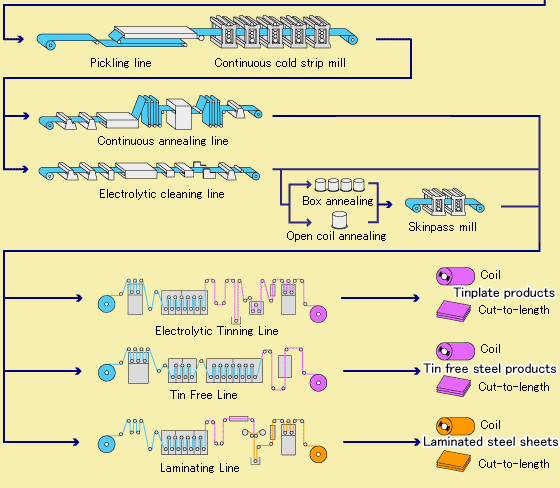tinplate production
Steel Output Increased Due to Price Rise
In October 2013, the output of global crude steel raised by 6.6%, reached 134 million MT. Steel prices have recovered from a three-year low hit in June, pushing some steel mills to increase capacity utilization. Based on the latest info from the World Steel Association on Wednesday, the steel production of China and others main steel producing regions strongly increased last month. Authority data shows that steel output in China, the top producer and consumer of the alloy rose 9.2% to 65.1 million MT. Asian output gained 8%, also helped by higher production in Japan, the world's second-largest steel producer. Europe as the second -largest producing regions, obtains a growth of 4%, and North America, third-largest producing area, increased by 6.6%.
Tinplate Brief History
Tinplate is coated with a layer of tin metal, which has anti-erosion property. It was first produced in Bohemia (now the Czech Republic and Slovakia), where the land is rich in metals, advanced technology, and know how to use hydraulic engaged in machinery manufacturing since the 14th century. In a very long period of time, there has been a major producer of tin plate in the world. Tinplate was mainly used to manufacture cutlery and drink ware.
Britain, France, Sweden intended to establish their own tinplate industry in the 17th century, but due to huge financial cost, their sweet came up with nothing. Until 1811, Brian Tang gold and John Hall opened tin of canned food, the only large-scale manufacture of tinplate developed. Today, the world annual production of about 250,000 tons of tin, 1/3 for the manufacture of tinplate, most of which is used to canned food industry.
detail info of stainless steel true bar
In this article, experts from professional tinplate supplier Mirach Metallurgy Co.,Limited share the detail info of stainless steel true bar. If you are looking for stainless plate products, you can visit www. mirachmetallurgy.com for more detail.
True Bar in stainless steel means the manufacture of the bar is rolled on the thickness and the width, attaining a more 90 degree relationship to thickness and width, unlike sheared and edged condition stainless, which is sheared from stainless plate, which offers a rough, usually out of square edge. True bar also may be defined as HRAP (hot rolled annealed and pickled), thus if you see a listing 304/304L HRAP, it is a True Bar, as this is a stainless rolled product.
Stainless Steel flat bar is stocked in both rolled flat bar (true flats) and processed flat bar (cut from plate) in our Montreal and Toronto locations. Our stainless flat bar is available in 304, 304L 316, and 316L. Stainless Steel bar is used for many corrosive resistant applications, and alloys are selected for their specific properties. If you need assistance in material or product selection, you can view our stainless steel data sheets or contact our sales team for assistance. Our stainless steel bar products are used in many applications including, but not limited to, Food Processing, Chemical Processing, Pulp & Paper, Aerospace, Automotive, Medical and Commercial Goods.
Tinplate Production Process
In this text, we discuss the topic of Tinplate Production Process. In this article, you can learn the whole process of tinplate manufacturing.
Tinplate production process as follows: tin plating of pickling low-carbon steel sheet → → softsolution processing → passivation → oiling → Check → shear → Category → packaging.
Tinplate by the metallographic analysis of its organizational structure as follows: a total of fivefrom the inside out.
(1) steel substrates. Can general with a thickness of 0.2 ~ 0.3MM.
(2) tin alloy layer. For the tin Ferroalloys structure, plating tin plate tin content to <1G/M2, hot-diptin plate for 5G/M2.
(3) tin layer. The tinned amount of the pure tin layer, electroplating tin plate the 5.6G/M2 ~ 22.4G/M2, hot-dip the tinplate 22.4G/M2 ~ 44.8G/M2.
(4) oxidation film. Mainly stannous oxide, tin oxide, etc..
(5) film layer. Cotton seed oil or dioctyl sebacate.


